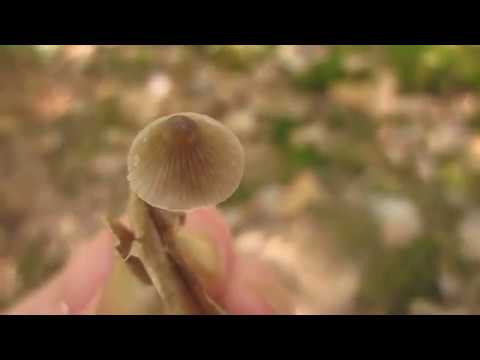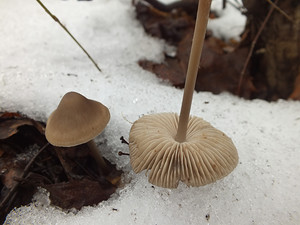Mycena inclinata
or
Mycenae motley
Inclined mycena (Mycena inclinata) is a fungus of the Mycene family, from the Mycene genus, is characterized as a reducent. Widely distributed in the European continent, Australia, Asia, North Africa, North America. The inclined mycene species also includes two special subspecies that were discovered and described in Borneo. The synonym is mycena variegated.
External description of the mushroom
The flesh of the inclined mycena is fragile, white and very thin, has no smell at all, but some mushrooms still have a barely noticeable unpleasant aroma.
The hymenophore of this type of fungus is represented by a lamellar type, and the plates in it are not too often, but not rare. They grow to the peduncle with teeth, have a light, sometimes grayish or pinkish color, cream shade.
The diameter of the cap of this type of mushroom is 2-4 cm, its shape initially resembles an egg, then it becomes blunt-annular. At the edges, the cap is lighter, uneven and chopped, gradually becomes convex-outstretched, with a noticeable tubercle in its central part. Sometimes in mature mushrooms, a dimple is visible at the top, and the edges of the cap become curved and covered with wrinkles. Color - from brown-gray to pale brown, sometimes turns into fawn. The tubercle in a mature inclined mycene often turns brown.
Habitat and fruiting period
The inclined mycena (Mycena inclinata) grows mainly in groups, choosing for its development the trunks of fallen trees, old rotten stumps. Especially often you can see this type of mushroom near oak trees in the forest. The most active fruiting of the inclined mycena falls on the period from June to October, and you can see this type of fungus in mixed and deciduous forests. The fruit bodies of the inclined mycena prefer to grow on deciduous tree species (oak, rarely birch). Fruiting annually, they are found in groups and whole colonies.
Edibility
Mycena inclinata is characterized as an inedible mushroom. In some sources, it is considered conditionally edible. In any case, it is not toxic.
Similar species, distinctive features from them
Research has allowed to prove a high level of genetic similarity of mycene inclined with such types of mycene as:
- Mycena crocata;
- Mycena aurantiomarginata;
- Mycena leaiana.
The outwardly inclined mycene is very similar to Mycena maculata and the bell-shaped mycene.
Remarks
For the first time, the description of the inclined mycene was made in 1838. A Swedish mycologist named Elias Fries named the new mushroom species Agaricus inclinatus. Inclined mycene received its current name in 1872, in the scientific works of another mycologist, whose name was Lucien Kele. Agaricus galericulatus calopus, described by the same Fries in 1873, and Mycena galericulata calopus, used in the scientific works of Peter Carsten in 1879, are also synonyms for the name of the represented species of mushrooms.
Row pointed (mouse): photo and description
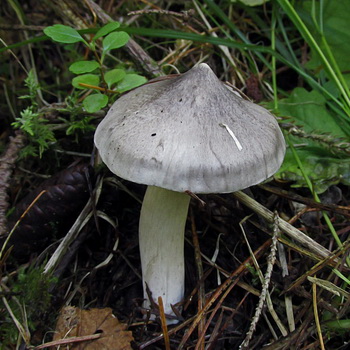
However, among the edible and tasty rowers there are poisonous species that can lead to food poisoning and cause significant harm to health. One of these representatives is a pointed row or a mouse row
In this regard, it is very important for each mushroom picker to follow the rules for collecting mushrooms, as well as to carefully study how to distinguish the mouse row from other edible rows.
Fans of "quiet hunting" assure that some ryadovki, considered poisonous in some countries, in our country are conditionally edible, which can be eaten. However, this does not in any way apply to the poisonous pointed row. Below is a photo of a pointed row, clearly showing how this mushroom looks and grows.
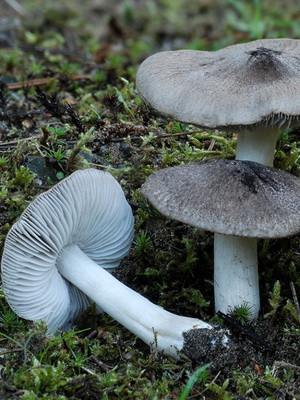
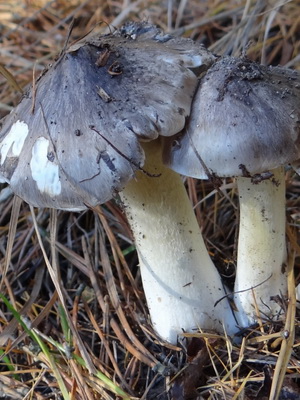
Usually, a pointed row (Tricholoma virgatum) is also called a mouse row, a burning-sharp row or a striped row. These names give an idea not only about the appearance, but also about the smell and taste. In some reference books, it is indicated as an inedible mushroom with a strong bitter taste that does not disappear even after a long soaking and boiling.
To form mycorrhiza, the mouse row chooses such tree species as pine, spruce, larch. Perhaps that is why this poisonous species can be found in coniferous and mixed forests of temperate climatic latitudes not only in Russia, but also in Europe, as well as North America. Rowing grows in groups or rows on moist, acidic soils. Fruiting occurs almost all autumn, until the first frost.
Here are photos of a striped row for your reference:
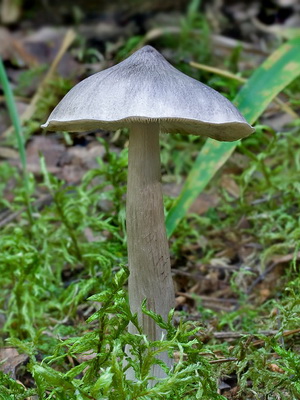
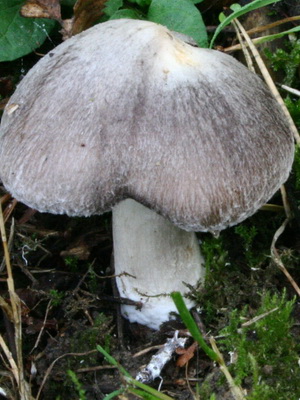
As you can see, this mushroom resembles an edible gray ryadovka. The active period of fruiting of both species occurs simultaneously. Therefore, in order not to confuse them and correctly distinguish between themselves, you need to know the main features of the appearance of each representative.
Pointed row ((Tricholoma virgatum): description and distribution
We suggest that you familiarize yourself with the description and photo of the pointed row mushroom, so that you have the opportunity to distinguish the poisonous species from the edible gray row.
Latin name: Tricholoma virgatum.
Family: Ordinary (Tricholomataceae).
Synonyms: mouse row, striped row.
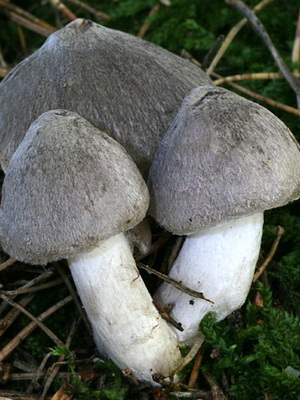

Hat: in diameter varies from 4 cm to 8 cm, sometimes it is 10 cm. A photo of a mouse row mushroom shows that the shape of the cap is bell-conical. At a more mature age, it becomes hump-shaped and convex. The color is ash gray, much darker in the central part, with a cone in the middle and with striped edges.
Leg: diameter from 0.5 cm to 2, sometimes up to 2.5 cm. A striped or pointed leg has a length of 5 to 8 cm. The shape is cylindrical, slightly thickened at the base. The color is white or gray, with clearly visible longitudinal stripes.
Flesh: When young, soft with a whitish-gray color. Then it becomes white, acquires a bitter taste and an unpleasant flour smell.
Plates: wide, frequent, deeply indentable, adherent to the pedicle with a tooth. They are white or gray in color, in adulthood they become gray. White spore powder with wide and oblong spores.
Application: Poisonous ryadovka pointed is not used in cooking because of its bitterness and chemicals harmful to the human body.
Distribution: grows in the same areas as the edible ryadovka gray - moist deciduous and coniferous forests. The harvesting season begins in September and ends at the first frost.
Similarities and differences: the pointed row is disguised as an edible mushroom - the row is gray, or earthy-gray.
Differences between the gray row and the mouse (with photo)
According to the photos presented above, gray mushrooms differ from mice not only in appearance, but also in taste and smell. Gray ryadovka belongs to category 4 and is an edible mushroom. It has a dark gray color of the cap with the flesh of the same shade and a weak mealy flavor. Old specimens become rotten and unattractive in appearance.
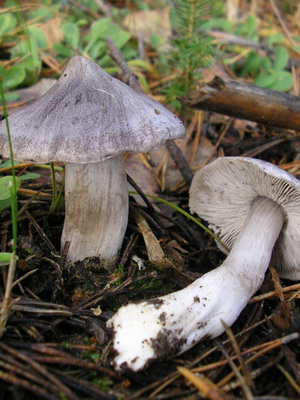

After reading this article with a description and photo of a mouse or pointed row, you can go into the forest for mushrooms. However, even with knowledge, you need to be careful about the mushroom harvest so as not to bring home this poisonous mushroom.
After about 40 minutes, and maybe 2-5 hours after consumption (depending on the amount of pointed row eaten), the first signs of poisoning begin: nausea, vomiting, diarrhea, sharp abdominal pain, decreased blood pressure and disruption of the cardiovascular system ... As soon as the first symptoms appear, it is necessary to urgently call an ambulance, and in the meantime, rinse the stomach.
Mycena striped

Mycena polygramma
- Mycenae crusted
- Mycenae striated
Mycena polygramma (Mycena polygramma) belongs to the family of the Ryadovkovs, Trichologovs.Synonyms for the name are mycena lamellar, mycena polygramma (Fr.) S. F. Gray.
External description of the mushroom
The cap of mycene striped (Mycena polygramma) has a bell-shaped shape and a diameter of 2-3 cm. The protruding plates make the edges of the cap uneven and serrated. There is a noticeable brown tubercle on the surface of the cap, and it itself has a grayish or olive-gray tint.
The spore powder is white. The hymenophore is of the lamellar type, the plates are characterized by a moderate frequency, are located freely, or grow slightly to the pedicle. the edges of the plates are uneven, serrated. Initially, they are whitish in color, then they become grayish-cream, and in adulthood - brown-pink. Red-brown spots may form on their surface.
The mushroom leg can reach 5-10 cm in height, and in rare cases - 18 cm. The thickness of the mushroom leg does not exceed 0.5 cm. The leg is even, rounded, and can expand downward. As a rule, the inside of this leg is empty, it is absolutely even, cartilaginous, characterized by great elasticity. A tapered outgrowth is located on it. The color of the mycene stem is usually the same as that of the cap, but sometimes it can be slightly lighter, bluish-gray or silvery-gray. The surface of the mushroom leg can be characterized as longitudinally ribbed. In its lower part, a fringing of whitish hairs is noticeable.
The flesh of striped mycene is thin, practically odorless, its taste is soft, slightly pungent.
Habitat and fruiting period
Active fruiting of mycene striped stems begins at the end of June and continues until the end of October. A mushroom of this species grows in coniferous, mixed and deciduous forests. The fruiting bodies of mycena polygramma grow on or near stumps, on wood buried in the soil. They are located singly or in small groups, not too tightly to each other.
Striped mycena (Mycena polygramma) is widespread on the territory of the Russian Federation.
Edibility
The mushroom has no nutritional value, so it is considered inedible. Although it cannot be classified as a poisonous mushroom, it contains no toxic substances.
Similar species, distinctive features from them
The set of features that characterize the striped mycene (namely, color, well-defined crown, legs with longitudinal ribs, substrate) do not allow this type of fungus to be confused with other common varieties of mycene.
Mushroom photo Mycena striped from questions in recognition:



















